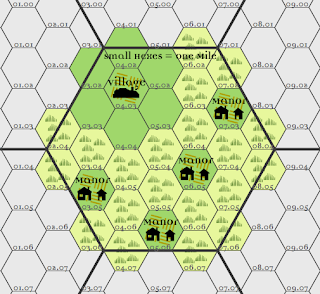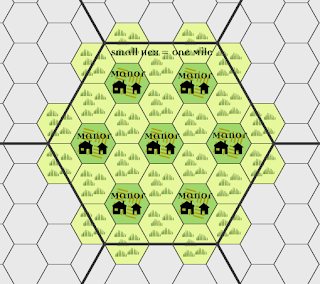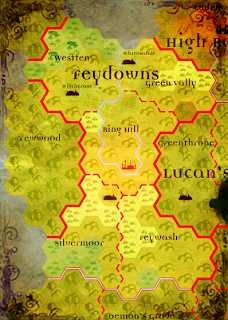The economy of the fantasy world in which my campaign is set consists of a network of interconnected economic forces: the feudal system, the guild controlled markets of the free cities, the economics of the various church holdings and the working of the various non-human cultures. Each one has its own unique political structure. Part one of this series will focus on the sub-economy which is among the most self-sufficient and the most familiar to players of fantasy RPGs.
(A warning for those playing editions in which characters gain experience through the acquisition of gold pieces; the economic system about to be described was not designed with character level advancement in mind. I suspect that this system will hinder character leveling if strictly followed and will collapse if characters are given enough wealth to level normally.)
Feudal Economics
Building from the previous series, we have obtained the population levels from the building block of manor farm to the level of the province. Now we will determine the economic power for those holdings.
The Economics of the Manor
The manor is mostly capable of supporting its self. Any surplus raw goods it produces, it trades with urban economy and receives manufactured items or coin in return. The value of a manor's agricultural surplus is based on the following:
The raw material cost of supporting the family of one urban dweller of average means equals one silver piece per day.
The cost per month is thus three gold pieces and the yearly cost is 36 gold pieces or 9 gold pieces a season. With the 1:2 urban to rural population ratio we previously established, it takes two rural farmers to produce this wealth. A manor house with a population of 100 could thus produce an agricultural surplus worth 450 GP a season and 1800 GP a year. Note, much of this wealth is in perishable form, such as taxed grain. We'll say only half one-tenth is in coin. Most coinage in circulation is copper and silver. Gold is very rare and platinum is never seen.
Each season, the lord of the manor may choose to tax this production lightly (1/4), moderately (1/3) or severely (1/2) and collect 112 GP 5SP, 150 GP or 225 GP respectively. The remainder is then divided among the manor population. With moderate taxation, 300 GP of value is returned to the community of 100 per season.
It follows that the family wage of an average rural dweller is about 3 copper pieces per day.
These wages are not completely out of step with the price list given in the 4e PHB. It helps to think of the value of a single copper piece as worth about 1 to 5 USD. One may think at first that the value of a longsword (15 GP) may be a bit steep (over 1500 USD) but its modern equivalent, an AR-15 assault rifle, costs about that much. Some items listed are off base, I think, like the longbow is probably far over-priced. Certainly player starting funds are far too high. Continued use of the existing treasure bundles listed in the 4e DMG is suggested. Characters who are actively adventuring are bound to get very rich, very quickly in comparison with manor bound landlords but the risks should offset the rewards. ;)
An important part of a manor lords obligation to his liege is his military service. It is in meeting this obligation that entire manor system exists. The wealth a manor generates in coin is not its only output; it provides the following military might for one season's worth of campaigning a year:
1 knight (manor lord) 10th level leader/soldier - Heavy Cavalry
2 knights bachelor 5th level soldiers - Heavy Cavalry
3 squires 3th level soldiers - Light Cavalry
1 cleric 3rd level leader/controllers - Medium Foot
10 Yeomen militia 1st level minions - Medium foot or Archers
17 total, 6 mounted, 11 foot
Can I get a stat box, please: Yikes, nevermind...
Manor, Low level law holding
A manor is a self-sufficient stationary estate, or fief that is under the control of a lord who enjoys a variety of rights over it and the peasants attached to it by means of serfdom.
Military
1 knight (manor lord) 10th level leader/soldier
2 knights bachelor 8th level soldiers
3 squires 3th level soldiers
1 cleric 3rd level leader/controllers
10 villein militia 1st level minions
17 total, 6 mounted, 11 foot
Buildings
1 manor house, fortified on 4, 5, 6 on d6
d4 manor out buildings
d4 craftsmen workshops
1 communal stockade
1 church, fortified on 5, 6 on d6
5d6 + 6 Small houses or huts
Goods Available
Food and drinks
Farm livestock
Clothing and material
Simple melee weapons
Military and simple ranged weapons
Leather armor
Simple tools
Population 100
Income per season 450 GP
GP Limit 225
Politics and Management below the Provincial Level
We will now build bigger political units such as baronies upon our manor base. First we should look at the limits of what a character can control directly and the political structure that has developed to extend the limits of power.
A character, PC or NPC, may only directly manage five (plus or minus the character’s int modifier) holdings or vassals directly. Vassals are limited by this rule as well. A manor lord at least holds the rank of knight. A manor lord granted more than one manor is usual also given the title of baron or baronet. Those with noble titles may invest lesser titles upon their own vassals. A vassal baron or baronet may control up to five manors. A viscount may control up to five barons or manors. A province is ruled by a count who may control up to five viscounts, barons or manors.
When a character grants holdings to vassals, the character loses the direct income on those holdings but may tax his vassals at 1/4, 1/3 or 1/2 of their incomes and can require the normal season of military service from them and any sub-vassals. If a vassal uses his sub-vassals' season of military obligations and is later called upon by his liege to provide all his military obligations, the vassal must pay his sub-vassals for their additional service or he risks angering his liege. Manors granted to a vassal may be scattered across the land, which may be desirable if the liege doesn't fully trust his underlings to concentrate their base of power.
For example, if a character, a viscount, controls 12 manors, he may directly manage 3 manors and must divide the remaining nine between two vassals as each vassal is also limited to five direct holdings. He invests two new barons and grants them five and four manors each. He loses the the direct income on the nine manors but my tax his new barons' income on those manors. The first baron provides 5 sub-vassal knights, 10 knights-bachelor, 15 light cavalry, and 55 footmen. The second baron provides 4 sub-vassal knights, 8 knights-bachelor, 12 light cavalry and 44 footmen. Both barons set moderate tax rates and earn incomes of 750 GP and 600 GP per season. The viscount taxes the first baron heavily for 375 GP and the second baron lightly for 150 GP and receives an income of 300 GP by moderately taxing his own manors. He receives a total of 825 GB this season and has 2 barons, 10 knights, 24 knights-bachelor, 36 light cavalry and 132 foot at his call. He may, in turn, be taxed by his liege, the count.
At this point, we have determined the average income of a lowly villein to that of a count!
Information at the Provincial Level
Let's review the Provincial population chart:
PROVINCE LEVEL
Level Population Largest Settlement
0 <> Thorp
1 1000 Hamlet
2 4000 Village
3 7000 Small Town
4 10000 Large Town
5 20000 Large Town
6 30000 Small City
7 40000 Large City
8 60000 Large City
9 80000 Metropolis
10 100000 Metropolis
Suppose we have a province with a population level of three ruled by a count. Of the 7000 able-bodied souls in that province we know that 2 in 3 are apart of the feudal economy. That gives us about 4620 people living on about 46 manors. With 46 manors, we know there is about 20,700 GP floating about in the local feudal economy of which only half one-tenth is in hard currency. (All those copper pennies...) There are probably nine barons in the province, and at least one viscount beneath the count.
I'm tempted to go into law holdings and domain play at this point but I think I'll save that for after the current series.
Thanks for reading!
Update (7/14/10):
I reduced the fraction of hard currency of the total wealth from one-half to one-tenth. I suspected one-half was a bit high and while doing the numbers for the next post I discovered a happy reinforcement between the one-tenth of total wealth number and a separate calculation for the total amount of actual gold in the system.






